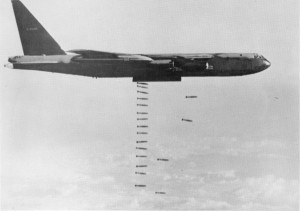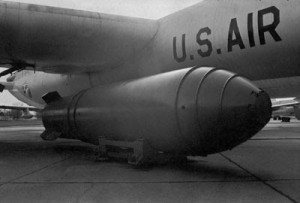 Because our world seems always to be at war, it is an unfortunate reality that bombs will exist…some legal, made for our military to keep us safe, some legal to blow up things for construction and other things, and of course some illegal, meant to bring terror and destruction. When I think about most bombs, the word terror definitely comes to the surface…be the bomb legal or not. Never is that more of a thought that when I think about the possibility of a bomb being lost, especially due to a plane crash. During the Cold War, as a means of maintaining first-strike capability, United States bombers carrying nuclear weapons circled the earth constantly…for decades. We just never knew when we could be attacked. We had to be…always ready.
Because our world seems always to be at war, it is an unfortunate reality that bombs will exist…some legal, made for our military to keep us safe, some legal to blow up things for construction and other things, and of course some illegal, meant to bring terror and destruction. When I think about most bombs, the word terror definitely comes to the surface…be the bomb legal or not. Never is that more of a thought that when I think about the possibility of a bomb being lost, especially due to a plane crash. During the Cold War, as a means of maintaining first-strike capability, United States bombers carrying nuclear weapons circled the earth constantly…for decades. We just never knew when we could be attacked. We had to be…always ready.
The problem with planes carrying bombs and in the air constantly, is the possibility of crashes. My thought, when a bomber crashes, is what happens to the bomb. In all reality, it’s a good question. There have been about three dozen accidents in which bombers either crashed or caught fire on the runway, resulting in nuclear contamination from a damaged or destroyed bomb and/or the loss of a nuclear weapon. We don’t often hear about these…especially when they happen in the United States, but let one happen in another country, and it’s a different story. When one of these bombs was lost, it was called a Broken Arrow, mainly to avoid panic, I’m sure. One of the only Broken Arrows to receive widespread publicity occurred on January 17, 1966. A B-52 bomber crashed into a KC-135 jet tanker over Spain.
The bomber was on route to its base in North Carolina, when the crash occurred dropping three 70 kiloton hydrogen bombs near the town of Palomares and one in the sea. The KC-135 was attempting to refuel the B-52, when the B-52 collided with the fueling boom. The fuel was ignited and the KC-135 blew up, killing its crew. Four of the seven crew members of the B-52 managed to parachute to safety…the rest were lost. The bombs were not armed, but with the first two, the explosive material exploded on impact, forming craters and scattering radioactive plutonium over the fields of Palomares. One bomb landed in a dry riverbed and remained intact, and the fourth landed in the sea. No one knew for sure where it was. The cleanup was massive.
Locating the bomb that had fallen into the sea took a bit longer. The Navy used an IBM computer, and experts tried to calculate where the bomb might have landed. They were very handicapped because of the size of the  impact area. Finally, a Spanish fisherman gave an eyewitness account that proved to be so accurate that on March 15th, with a much smaller search area, a submarine spotted the bomb. The bomb was recovered on April 7th, damaged but intact, and everyone breathed a sigh of relief. This particular accident was widely reported, because it was on foreign soil. It makes me wonder why there is so little reporting on American soil Broken Arrows. To this day, two hydrogen bombs and a uranium core lie in yet undetermined locations in the Wassaw Sound off Georgia, in the Puget Sound off Washington, and in swamplands near Goldsboro, North Carolina. I suppose some people knew of these lost bombs before, but I did not…until now.
impact area. Finally, a Spanish fisherman gave an eyewitness account that proved to be so accurate that on March 15th, with a much smaller search area, a submarine spotted the bomb. The bomb was recovered on April 7th, damaged but intact, and everyone breathed a sigh of relief. This particular accident was widely reported, because it was on foreign soil. It makes me wonder why there is so little reporting on American soil Broken Arrows. To this day, two hydrogen bombs and a uranium core lie in yet undetermined locations in the Wassaw Sound off Georgia, in the Puget Sound off Washington, and in swamplands near Goldsboro, North Carolina. I suppose some people knew of these lost bombs before, but I did not…until now.


Leave a Reply